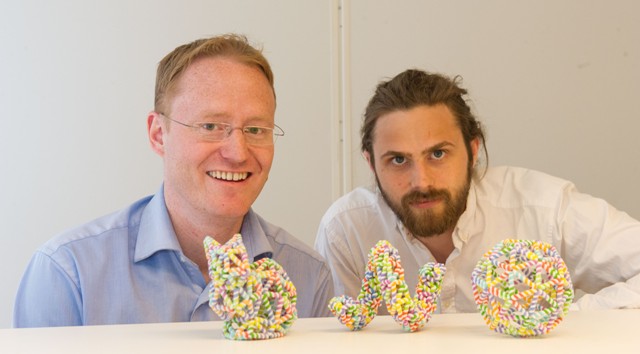Researchers at Karolinska Institutet, Sweden, and Aalto University, Finland, have developed a new technique to synthesize 3D nanostructures from DNA. This novel method enables synthesis of 3D DNA origami structures that have the ability to endure the body's low salt concentrations. This development paves the way for using DNA nanotechnology in new biological applications. Furthermore, the highly automated design process enables the creation of complex synthetic DNA nanostructures.
 Björn Högberg and Erik Benson. Credit: Ulf Sirborn
Björn Högberg and Erik Benson. Credit: Ulf Sirborn
This novel technique is considered to be similar to 3D printing nanoscale structures. The desired structure is drawn as a polygon object using the 3D software that is used in animation or computer-aided design. The DNA sequences required for creating the structure are then calculated using optimization techniques and graph-theoretic algorithms.
The team then combined the synthesized DNA sequences in a salt solution, where the DNA sequences assembled themselves into the right structure. Using DNA to build nanostructures is particularly advantageous as their bases bind to one other in a predictable manner through base-paring.
“This new method makes it very easy to design DNA nanostructures and gives more design freedom,” says study leader Björn Högberg from the Department of Medical Biochemistry and Biophysics at Karolinska Institutet. “We can now make structures that were impossible to design previously and we can do it in the same way as one might draw a 3D structure for printing out in macroscopic scale, but instead of making it out of plastic, we print it in DNA at the nanoscale.”
The team demonstrated the technique by creating a DNA printout of the Stanford Bunny, a common test for 3D modelling. They also created a rod, a spiral, a ball and a bottle-shaped structure. This new technique is not only more simple than existing methods for making DNA origami, but it also does not require a high concentration of magnesium salt.
“For biological applications, the most crucial difference is that we can now create structures that can be folded in, and remain viable in, physiological salt concentrations that are more suitable for biological applications of DNA nanostructures,” explains Dr Högberg.
“An advantage of the automated design process is that one can now deal systematically with even quite complex structures. Advanced computing methods are likely to be a key enabler in the scaling of DNA nanotechnology from fundamental studies towards groundbreaking applications,” says Professor Pekka Orponen, who directed the team at the Aalto University Computer Science Department.
Previously, the Karolinska Institutet team had created a DNA nano-caliper to study cell signaling. The novel method developed in this new study would enable similar biological experiments to be performed in a manner that is very similar to the conditions within cells. DNA nanostructures have been used in medical applications for delivery of cancer drugs directly to tumour cells using targeted capsules – a method that requires a smaller amount of drugs.
The study paper entitled, ‘DNA rendering of polyhedral meshes at the nanoscale’, has been published online in Nature journal.
Other researchers who contributed to this study include, Erik Benson, Johan Gardell, Eugen Czeizler, Sergej Masich, and Abdulmelik Mohammed.
The Swedish Research Council, the Knut and Alice Wallenberg Foundation, the Swedish Foundation for Strategic Research, and several other bodies provided funding for this study.